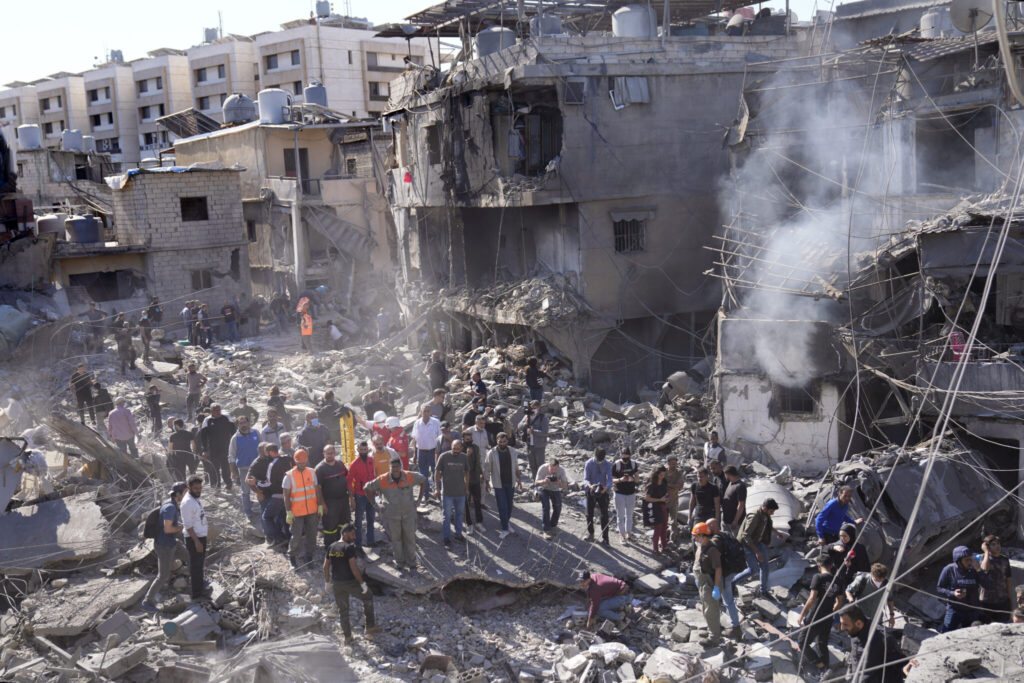Blinken Israel visit/ U.S. cease-fire efforts/ Hamas leader killed/ Hezbollah tensions/ Israel strikes Lebanon/ Gaza humanitarian crisis/ Newslooks/ Morning Edition/ J. Mansour/ Secretary of State Antony Blinken arrived in Israel to push for a cease-fire and increase humanitarian aid to Gaza amid ongoing conflict. The visit comes after the killing of Hamas leader Yahya Sinwar, which has escalated tensions with Hezbollah and fears of wider conflict. Blinken aims to address Gaza’s humanitarian crisis, potential Israeli strikes on Iran, and efforts to release hostages held by Hamas.

Blinken in Israel to Push Cease-Fire Amid Tensions: Quick Looks
- Secretary of State Antony Blinken visits Israel to renew cease-fire efforts after the killing of Hamas leader Yahya Sinwar.
- Israeli airstrikes have intensified in Lebanon, with hospitals fearing they will be targeted amid the ongoing conflict with Hezbollah.
- Blinken’s trip follows heightened tensions with Iran, which has vowed retaliation if Israel strikes, while both U.S. and Iranian officials engage in regional diplomacy.
- The U.S. aims to increase humanitarian aid to Gaza and is pressuring Israel to lift barriers hindering relief efforts.
Blinken in Israel to Renew Cease-Fire Talks After Hamas Leader Killed
Deep Look:
Secretary of State Antony Blinken arrived in Israel on Tuesday as the U.S. intensifies efforts to broker a cease-fire between Israel and Hamas, following the death of top Hamas leader Yahya Sinwar. Blinken’s visit, his 11th to the region since the war’s outbreak over a year ago, underscores the Biden administration’s urgent push to ease tensions, secure the release of hostages, and alleviate the humanitarian crisis in Gaza.
The conflict, which began with Hamas’ deadly attack on Israel on October 7, 2023, has since expanded to include Hezbollah in Lebanon, with Israel launching a ground invasion earlier this month. The situation was further inflamed by Iran’s ballistic missile attack on Israel on October 1, prompting concerns that Israel may retaliate.
Hours before Blinken landed, Hezbollah launched rockets into central and northern Israel, triggering air raid sirens but causing no significant damage. The Israeli military intercepted most of the rockets but has ramped up airstrikes targeting Hezbollah strongholds in Lebanon, contributing to rising civilian casualties and widespread destruction.
Lebanese Hospitals Under Threat
The humanitarian situation in Lebanon has worsened, with hospitals increasingly under threat. Israeli airstrikes destroyed buildings near Rafik Hariri University Hospital, Lebanon’s largest public hospital, leaving 13 dead and dozens injured. Hospital staff reported broken windows and damaged facilities, with solar panels destroyed in the blasts. Medical teams were left scrambling as injured patients flooded the hospital in the aftermath of the strikes.
Staff at Sahel General Hospital also expressed fear after Israel accused Hezbollah of hiding millions of dollars in cash and gold in the hospital’s basement—an allegation denied by hospital officials. While Israeli forces claim they are not targeting hospitals directly, the pattern of attacks near medical facilities has created widespread fear. Many patients have already been evacuated.
International law protects hospitals from military strikes unless they are being used for military purposes, but hospitals that lose their civilian status risk being targeted in the conflict.
Cease-Fire Talks in Focus
During his visit, Blinken will meet with Israeli Prime Minister Benjamin Netanyahu and other leaders to discuss the prospects of a cease-fire, especially in Gaza. A key issue for the U.S. is ramping up humanitarian aid to the region, where thousands of Palestinians are displaced, and infrastructure has been devastated by Israeli airstrikes.
The State Department noted that Blinken’s trip will also involve talks about securing the release of hostages held by Hamas, a critical point of contention between Israel and the militant group. Previous cease-fire talks have stalled, with both sides accusing each other of making unreasonable demands. However, U.S. officials are hoping that Blinken’s presence can restart negotiations.
Earlier efforts brokered by the U.S., Egypt, and Qatar aimed to secure a deal in which Hamas would release hostages in exchange for an end to the war and the release of Palestinian prisoners. But those negotiations broke down in August. Hamas insists its demands remain unchanged despite Sinwar’s killing.
Escalating Tensions with Iran
The situation is further complicated by the looming threat of an Israeli strike on Iran. Israel has made clear its intention to retaliate for Iran’s ballistic missile attack earlier this month, leading to heightened diplomatic activity across the region. Blinken’s visit follows increased outreach from Iranian officials, who are seeking assurances from Gulf Arab nations that they will not allow their territories to be used for an Israeli strike.
Iran’s Foreign Minister Abbas Araghchi said Tuesday that Gulf Arab countries, including Qatar and the UAE, have pledged not to allow their airspace to be used for strikes against Iran. While these nations have not made public assurances, Iran’s statements reflect concerns that the conflict could escalate into a broader regional war.
Gulf nations like Qatar, Saudi Arabia, and the UAE host significant U.S. military installations, which could become targets in the event of a wider conflict.
Lebanon and Gaza: The Battle Rages On
Meanwhile, in Lebanon, Israel continues its bombardment of Hezbollah positions in southern Beirut and other Hezbollah strongholds. Hezbollah, in turn, has fired hundreds of rockets into Israel, including projectiles reaching the country’s central regions. The conflict has displaced large parts of southern Lebanon’s population, with thousands fleeing to escape the violence.
In northern Gaza, Israeli forces are conducting a major military operation, leading to massive civilian casualties and the destruction of infrastructure. Health officials in Gaza report over 42,000 Palestinian deaths since the conflict began, though the number of combatants killed is unclear. The war has displaced 90% of Gaza’s population of 2.3 million.
The conflict shows no signs of abating, with both Israel and Hamas digging in, despite international pressure for a cease-fire.







